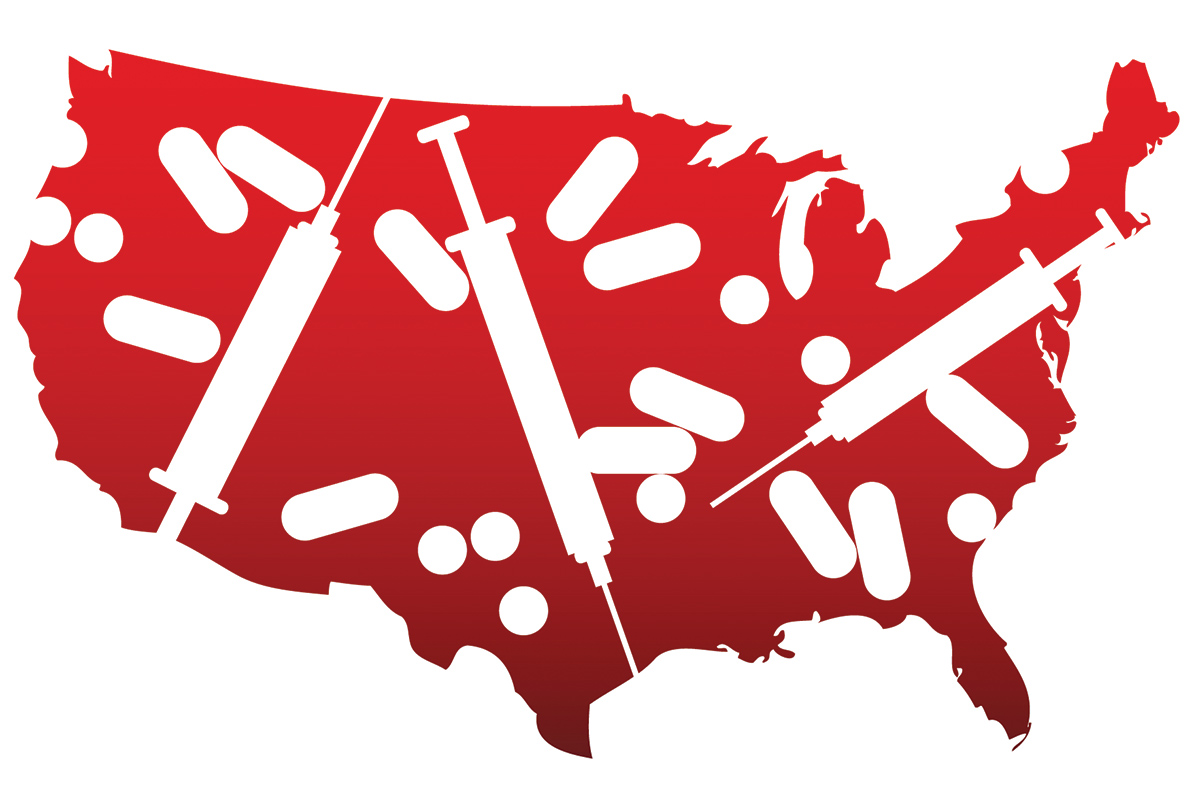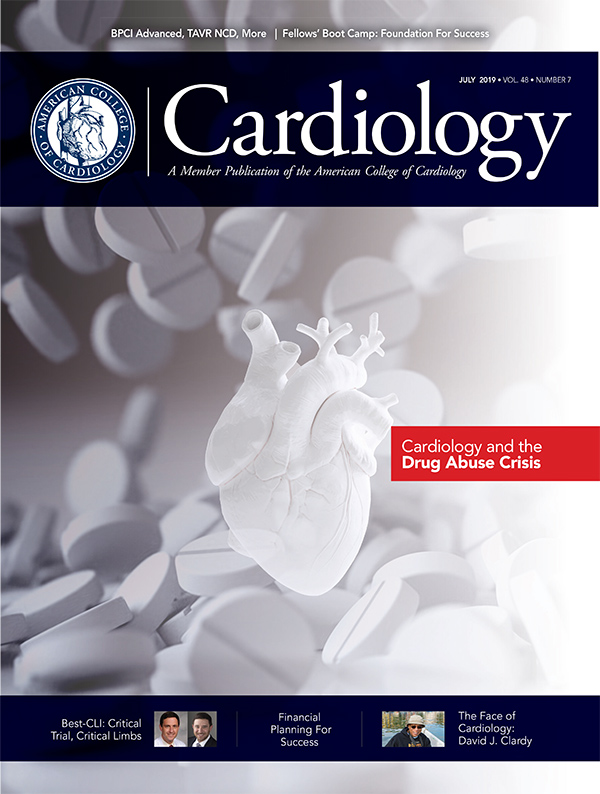Editor's Corner | The Opioid Crisis: A Call to Action for Cardiovascular Professionals

Deaths from opioids have become a national crisis. Data from the National Institute on Drug Abuse report that more than 130 people die every day from overdoses. The Centers for Disease Control and Prevention estimate that the economic burden of prescription opioid abuse is $78.5 billion a year.1
This includes the costs of health care, lost productivity, addiction treatment and criminal justice involvement. Common drugs involved in prescription opioid overdose deaths include natural opioids such as morphine and codeine; semi-synthetic opioids such as oxycodone, hydrocodone, hydromorphone and oxymorphone; and methadone which is commonly used to treat opioid use disorders.
The cover story of Cardiology this month highlights the magnitude of the opioid crisis and that cardiovascular professionals are likely to encounter patients who have or will develop heart disease while on opioid therapy.
This problem is particularly relevant to caring for older adults treated with opioid therapy for chronic pain given issues with medical comorbidities, high incidence of polypharmacy, impaired metabolism and reports of increased cardiovascular event rates in older adults.2
In the U.S. between 1999 to 2017 almost 218,000 people died from opioid overdoses. Opioid deaths were five-times higher in 2017 than in 1999. Data from the Commonwealth Fund shows states in New England, the Mid-Atlantic and several Southeastern states have been particularly hard hit by the opioid epidemic.
West Virginia, Ohio, Pennsylvania, the District of Columbia, Kentucky, Delaware and New Hampshire stand out as having the highest death rates from drug overdoses. In Pennsylvania, Maryland and Ohio, mortality rates from drug overdoses were at least five-times higher than rates for alcohol-related deaths and about three-times higher than suicide rates.
Three to 19 percent of people taking prescription pain medications will develop an addiction to these medications and 45 percent of heroin users started with a prescription opioid addiction. Heroin accounted for nearly one-third of opioid deaths in 2017 and a person's likelihood of dying from an opioid overdose for the first time exceeded the risk of dying in a motor vehicle crash.
The impact of opioids on heart health has been receiving increasing attention. A 34 percent increase in the risk of atrial fibrillation was found in veterans who used opiates compared with those who did not in a study of atrial fibrillation prevalence.3 QT prolongation and torsade de pointes have been described in HIV-infected individuals who were treated with methadone.
Another study looking at patients with heart disease who leave the hospital with prescription opioids found they may be more likely to miss follow-up care or to participate in cardiac rehabilitation as compared with those not prescribed opioids.4
One study published earlier this year showed that prescription opioid use may represent a novel cardiac risk burden, and is associated with a nearly two-fold increased risk of cardiovascular disease in patients with vs. without posttraumatic stress disorder.5
The physiologic effects of some opioids include hypotension, histamine release, decreased myocardial contractility and effects on cardiac conductivity including the potential to prolong the QT interval.6 Some recent studies suggest an epidemic of opioid-induced heart failure in younger adults.
The opioid epidemic has changed the epidemiology of infectious endocarditis and has been associated with a dramatic rise in cases presenting for care.7-9
The topic of integrating infectious disease considerations with response to the opioid epidemic has become an additional focus of interest for the National Academy of Medicine (NAM).
Researchers from Ohio State University reported a 436 percent rise in hospital admission for infectious endocarditis between 2012 and 2017 with heroin implicated in most of the drug-related cases.8
The Wexner Medical Center in Ohio had 395 cases of endocarditis in 2017 with drug use accounting for 177. One of four patients admitted for drug-related infective endocarditis died in the hospital.
The opioid crisis is a call to action for cardiovascular professionals. The U.S. Department of Health and Human Services has identified five specific priorities to address this national health emergency:
- Improving access to treatment and recovery services.
- Promoting use of overdose-reversing drugs.
- Strengthening our understanding of the epidemic through better public health surveillance.
- Providing support for cutting edge research on pain and addiction.
- Advancing better practices for pain management.

Cardiovascular professionals need to raise awareness on how to manage opioid overdoses, including CPR and the use of reversal agents such as naloxone. We need to better understand the management of acute pain and the multiple treatment options that do not include opioids.
In response to the opioid crisis, NAM announced in April 2019 that more than 100 organizations across the U.S. have joined it in declaring their commitment to reversing these national trends in opioid use.
The Action Collaborative on Countering the U.S. Opioid Epidemic is a public-private partnership committed to developing, curating and disseminating multisector solutions designed to reduce opioid misuse and improve outcomes for those affected by the opioid crisis.
We need to stem the "rising tide of deaths" from the "flood of opioids" in the U.S.10
References
- Centers for Disease Control and Prevention. Understanding the epidemic. Available here. Accessed June 27, 2019.
- Weiss AJ, Heslin KC, Barrett ML, et al. Opioid-related inpatient stays and emergency department visits among patients aged 65 years and older, 2010 and 2015. Statistical Brief #244. Healthcare Cost and Utilization Project (HCUP). September 2018. Available here. Accessed July 1, 2019.
- Stock J, Chui P, Rosman L, et al. Circulation 2018;138:A12773.
- Liberman JS, Samuels LR, Goggins K, et al. J Am Heart Assoc 2019;8:e010664.
- Scherrer JF, Salas J, Lustman P, et al. Eur J Prev Cardiol 2019;May 13:2047487319850717.
- Zagaria MA. US Pharm 2018;43:6-9.
- Mori M, Brown K, Bin Mahmood SU, et al. J Am Coll Cardiol 2019;73 (9 Suppl 1):1968.
- Day S, Patel N, Maffett S. J Am Coll Cardiol 2019;73 (9 Suppl 2):21.
- Weir MA, Slater J, Jandoc R, et al. CMAJ 2019;191:E93-E99.
- Okie S. N Eng J Med 2010;363:1981-5.
Clinical Topics: Arrhythmias and Clinical EP, Cardiovascular Care Team, Heart Failure and Cardiomyopathies, SCD/Ventricular Arrhythmias, Atrial Fibrillation/Supraventricular Arrhythmias, Acute Heart Failure
Keywords: ACC Publications, Cardiology Magazine, Analgesics, Opioid, Oxymorphone, Hydrocodone, Oxycodone, Heroin, Hydromorphone, Codeine, Drug Overdose, Morphine, Methadone, Naloxone, National Institute on Drug Abuse (U.S.), Acute Pain, Chronic Pain, Opiate Alkaloids, Pain Management, Cardiac Rehabilitation, Torsades de Pointes, Atrial Fibrillation, Public Health Surveillance, Public-Private Sector Partnerships, Criminal Law, Stress Disorders, Post-Traumatic, Veterans, Aftercare, Histamine Release, Opioid-Related Disorders, Endocarditis, Centers for Disease Control and Prevention, U.S., Polypharmacy, Heart Failure, Comorbidity, Suicide, Hypotension, HIV Infections, Health Services Accessibility, Cardiopulmonary Resuscitation
< Back to Listings


